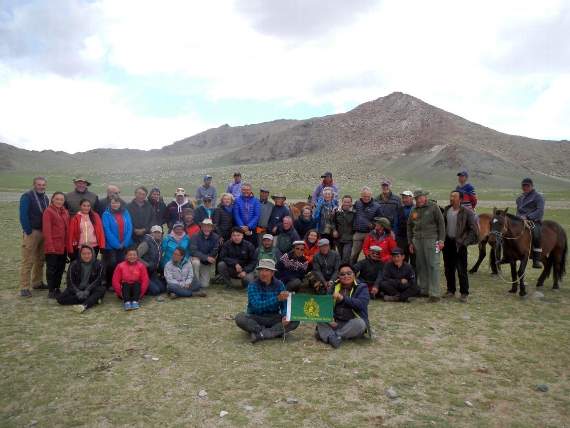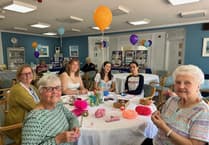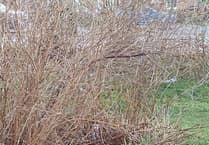FOR two women looking for a riding holiday, Bridget Grande and Jane Lewis could have had no idea of the magical, exotic and exhilarating voyage of discovery that was ahead of them when they joined Colonel John Blashford-Snell’s Mongolian Baatar Expedition in July.
For Bridget, who lives in Upper Wield and is married to Robert and has two grown up sons, it was the chance of a lifetime to see Mongolia, a place she had dreamed about visiting since she was a child.
And she was joined by an equally excited Jane, who hails from Shalden.
Both experienced horsewomen, Bridget said: “Jane and I were looking for a riding holiday and felt this was a great opportunity.”
However, they would be riding Mongolian horses, which are unshod, and although used to being ridden can, according to the Col John account, be a little on the wild side.
Bridget was to get her first encounter with them when, after arriving at Ulaan Baatar Airport, as the expedition which included scientists’ doctors, a dentist and archaeologists, made its way into town, “I saw Mongolian horses running over the very rocky terrain, sure footed and going very fast”.
“Later, we saw yaks frolicking around the meadows, which was a funny sight,” she added.
They arrived as the town, where the temperature was 30 degrees, was holding a festival.
“And we were greeted with people in beautiful costumes and given such a warm friendly welcome,” said Bridget.
“They offer you salted butter tea made either with cow’s or yak milk. They had herds of goats and yaks all milling around.”
Once Jane and Bridget had been allocated their horses they were on their way.
“They weren’t really wild,” she said, “but we had a problem as they didn’t understand our language and we had to learn how to say stop and go in Mongolian.”
Bridget also found that she hadn’t taken enough clothes as high in the mountains “it was freezing cold and I ended up wearing everything I had”.
“But I did buy a traditional dress, a deel, which is very warm and comfortable to wear.”
The scientific expedition was gathering information that would also be shared by the Mongolian National University, and although she wasn’t officially one of the archaeologist or botanists, Bridget found herself being entranced by the carpets of wild flowers they rode over and the abundance of butterflies and bird life.
One day, although in the distance, the expedition saw a herd of snub-nosed Saiga antelope, an endangered species which sparked David Attenborough to raised concern over their decline on one of his nature programmes.
“It was exciting and we were lucky to have seen them,” said Bridget.
On their return journey, when they stopped at the Uhstain National Park, both Jane and Bridget saw more Przewalski horses, a herd of 400 which they had seen during their journey. They are the world’s last wild horses, having been hunted to extinction, but in Mongolia, thanks to an intensive breeding programme, they are on the increase.
For Bridget ,one of the highlights was the chance to join the archaeological group when they went to look at Bronze Age tombs.
“Tombs that few have seen before and date around the time of our Stonehenge,” she said. “They were beautifully carved and around them were green meadows and flowers and you could smell the perfume in the air.”
Life got a little more rugged when they had to climb up the rocky hillside, but all the horses got their riders safely to the various camps where they slept in tents and washed in river water.
What also impressed the East Hampshire travellers was the hospitality and friendship on offer.
It was an experience of a lifetime, according to Bridget, and when she returned she thanked the people at the Riding for the Disabled Association at Medstead, where she had gone to help improve her riding and learn more about horse behaviour before setting off for Mongolia.
“They were a marvellous help and they do such good work there,” she said.
Jane admitted: “I just wanted to go on a riding holiday with a friend, but it got a bit out of hand, but it was a wonderful experience.”
It was also an experience where she could use her scientific knowledge as she has a degree in micro-biology as well as other degrees in the same field, so she was interested in both the science and zoological aspect of the trip and took a great interest in the wildlife.
“It was wonderful to have golden eagles just floating in the air around you and, of course, the animals. The yaks, the camels and the Mongolian horses were a new experience,” said Jane.
She admitted the expedition had been a “trail of discovery” which took them to some “pretty desolate places”.
“Some places were very high up and so cold that there was ice on the inside of our tent,” mused Jane, who added that she found it strange that Khovd was “a big city in the middle of nowhere”.
But her trip didn’t get off to a good start.
“I had brought bags of kit and they lost it at the airport when we arrived. I did get it the following day but, on our return, they lost my luggage again,” she laughed.
Although in wild areas few outsiders have visited, Jane said she felt safe the whole time.
“We were so well looked after and a we had good food supplied by our cook working out of a big Russian lorry,” she explained.
“What I will also remember is how friendly the people where. I had always wanted to go to Tibet, Bhutan and Mongolia and this was a wonderful chance and, like Bridget, seeing those ancient, carved tombs was a highlight.”
Jane, who is married to Aeandi, and has her own horse which she keeps near her Shalden home, is a member of the Alton Choral Society and, now home, is now busy with rehearsals for their autumn concert.
The expedition was supported by The Scientific Exploration Society and John Blashford-Snell, who co-founded it, has written a fascinating account of what they experienced and talks of their search for the Prizewalski horses, discovered in 1878 by Russian Army Colonel Nikolai.





Comments
This article has no comments yet. Be the first to leave a comment.